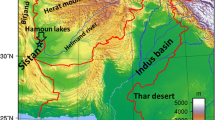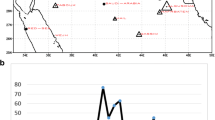Abstract
The evolutionary characteristics of a dust storm over Oman on 2 February 2008 were studied by analyzing the weather associated with it. The National Center for Environmental Prediction/National Centre for Atmospheric Research (NCEP/NCAR) reanalysis wind flow pattern at 1,000 hPa showed a clockwise and outward wind flow pattern over the study region, a manifestation of a high-pressure cold air mass. In addition, ground truth observations for surface temperature and surface winds showed cold northerly winds until the early morning of 2 February 2008. A strong wind shear resulted from differences in wind speed between warm air and trapped cold air. This vertical wind shear enhanced instability. Furthermore, the weakening of the inversion in the lower troposphere and the formation of a mixed layer due to transfer of horizontal momentum from upper air towards the surface led to strong surface winds. These strong winds lifted a large amount of dust particles off the ground, resulting in the dust event of 2 February 2008.












Similar content being viewed by others
References
Abdul-Wahab SA, Al-Saifi SY, Alrumhi BA, Abdulraheem MY, Al-Uraimi M (2004) Determination of the feature of the low level temperature inversionsabove a suburban site in Oman using radiosonde temperature measurements: long term analysis. J Geophys Res 109:D20101. doi:10.1029/2004JD004543
Aoki I, Kurosaki Y, Osada R, Sate T, Kimura F (2005) Dust storms generated by Mesoscale cold fronts in the Tarim Basin, Northwest China. Geophys Res Lett 32:L06807. doi:10.1029/2004GL021776
Chang SC, Chou CCK, Chen WN, Lee CT (2010) Asian dust and pollution transport—a comprehensive observation in the downwind Taiwan in 2006. Atmos Res 95:19–31
Chrysoulakis N, Spiliotopoulos M, Domenikiotis C, Dazelios N (2003) Towards monitoring of regional atmospheric instability through MODIS/AQUA images. In: Proceedings of the international symposium on GIS and Remote Sensing: environmental applications, held at Volos, Greece, 7–9 November 2003, pp 155–166
Dong ZB, Wang HT, Liu XP (2002) Velocity profile of a sand cloud blowing over a gravel surface. Geomorphology 5:277–289
Gao T, Jingato L, Xiao L, Liang K, Yida F, Yinghua H (2002) Objective pattern discrimination model for dust storm forecasting. Meteorol Appl 9:55–62
Glen T (1954) An Introduction to climate, 3rd edn edn. McGraw-Hill, New York
Heintzenberg J (2007) Desert dust over Europe. Ger Res 29:20–23
Holben BN, Eck TF, Slutsker I, Tanre D, Buis JP, Setzer A, Vermote E, Reagan JA, Kaufman YJ, Nakajima T, Lavenu F, Jankowiak I, Smirnov A (1998) AERONET—a federated instrument Network and data Archive for Aerosol characterization. Remote Sens Environ 66:1–16
Idso SB (1976) Dust storms. Sci Am 235:108–114
Iwasaka YH, Minoura H, Nagaya K (1983) The transport and spatial scale of Asia Dust storm clouds: a case study of the dust storm event of April, 1979. Tellus 35B:189–196
Kahl JD, Serezze MC, Schnell RC (1992) Tropospheric low level temperature inversions in the Canadian Arctic. Atmos Ocean 30:511–529
Kendrew (1961) The climate of continents, 5th edn. Oxford University Press, New York
Legrand M, N’doume C, Jankoviak I (1994) Satellite derived climatology of the Saharan aerosol. In: Passive infrared remote sensing of clouds and the atmosphere II. Lynch, D.K. (Ed.). SPIE 2309:127–135
Matson M, Holben B (1987) Satellite detection of tropical burning in Brazil. Int J Remote Sens 8:509–516
McTainsh G, Chang YC, McGowan H, Leys J, Tews K (2005) The 23 October 2002 dust storm in Eastern Australia: characteristics and meteorological conditions. Atmos Environ 39:1227–1236
Middleton NJ (1986) A geography of dust storms in South West Asia. Int J Clim 6:183–196
Nazarov BI, Abdullaev SF, Maslov VA (2010) Studies of temperature effects of dust storms. Izvestiya Atmos Ocean Phys 46:476–481
Natsagdorj L, Jugder D, Chung YS (2003) Analysis of dust storms observed in Mongolia during 1937–1999. Atmos Environ 37:1401–1411
Orlovsky L, Orlovsky N, Durdyev A (2005) Dust storms in Turkmenistan. J Arid Environ 60:83–97
Prinz EN, Menzel WP (1992) Geostationay satellite detection of biomass burning in south America. Int J Remote Sens 13:2783–2799
Simpson JJ, Hufford GL, Servranckx R, Berg J, Pieri D (2003) Airborne Asian dust: case study of long range transport and implications for the detection of volcanic ash. Weather Forecast 18:121–141
Sokolik IN (2002) The spectral radiative signature of windblown mineral dust: implications for remote sensing in thermal IR region. Geophys Res Lett 29:2154. doi:10.1029/2002GL15910
Thomas S (1987) Cloud forests in humid tropics. The United Nations University Press
Tsunematsu N (2005) Observed dust storm over the Taklimakan desert on April 13, 2002. Sci Online Lett Atmos 1:21–24
Tsunematsu N, Iwai H, Ishii S, Yasui M, Murayama Y, Mizutani K (2009) Influence of surface-based stable layer development on Asian dust behavior over Tokyo. Boundary Layer Meteorol 131:263–275
University of Wyoming (2003) Atmospheric soundings web site. University of Wyoming, Department of atmospheric Science, Laramie, USA. (URL: http://weather.uwyo.edu/upperair/sounding.html)
Wang MX, Winchester JW, Cahill TA, Ren LX (1982) Chemical elemental composition of windblown dust, 19 April 1980, Beijing. Kexue Tongbao 27:1193–1198
Zheng X, Lu F, Fang X, Fang Y, Guo L (1998) A study of dust storms in China using satellite data. In: Optical remote sensing of the atmosphere and clouds (Eds. Wang J, Wu B, Ogawa T, Guan Z). SPIE 3501:163–168
Zhou M, Shaohou Q, Ximing S, Yuying L (1981) Properties of aerosols during a dust storm over Beijing area. Acta Sci Circumst 1:207–219
Acknowledgements
The authors thank the MODIS Land Rapid Response Team at NASA for sharing their observations, and acknowledge the NOAA-CIRES Climate Diagnostic Center, Boulder, USA for the NCEP reanalysis data. We also appreciate the timely help received from Phillip Gladstone for arranging weather history data (http://wunderground.com). We are also grateful to two anonymous reviewers for their constructive criticism and suggestions that led to great improvements in the manuscript. We also thank Dr. Blaise Desouza, Indian Institute of Soil Science, Bhopal for linguistic improvements to the manuscript.
Author information
Authors and Affiliations
Corresponding author
Additional information
Responsible Editor: F. Mesinger.
Rights and permissions
About this article
Cite this article
Desouza, N.D., Simon, B. & Qureshi, M.S. Evolutionary characteristics of a dust storm over Oman on 2 February 2008. Meteorol Atmos Phys 114, 107 (2011). https://doi.org/10.1007/s00703-011-0163-7
Received:
Accepted:
Published:
DOI: https://doi.org/10.1007/s00703-011-0163-7




